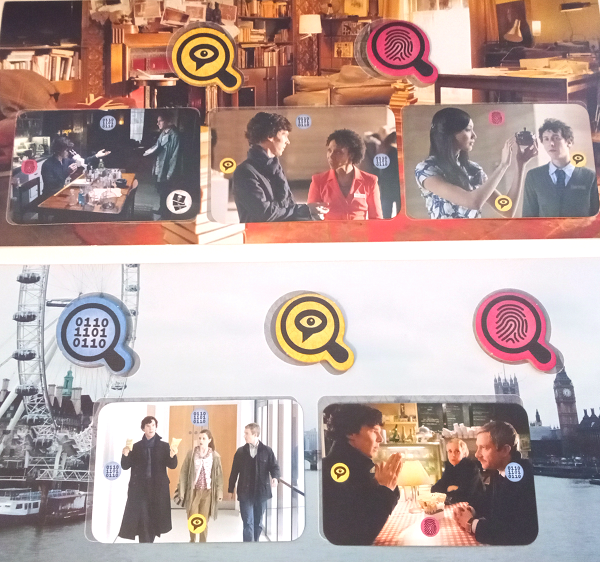Outwit and Outperform Your Fellow Detectives in Sherlock: Case Connection

The game is afoot! Draw connections between evidence and leads to find killers and crack the case.
Published by Lucky Duck Games, and designed for 2-4 players with a game time of roughly 30 minutes, Sherlock: Case Connection is not another one of Lucky Duck's detective-style deduction games. Rather, it’s a tight, fast-playing puzzle game of matching symbols.
Gameplay
The four location boards are placed in the center of the table. Each one has spaces for thread cards and for proof tokens, which are filled accordingly. Each player then draws two lead cards, chooses one to place face-up in front of them, and returns the other to the bottom of the lead deck.
A lead card is worth a certain number of points when completed. Each one will also have its own combination of icons along some or all of its four edges. These icons match the proof tokens and the icons shown on the thread cards. There are three such icons: witness, forensic, and cyber icons.
On your turn, you choose one of the location boards and take two things from it (any combination of cards and/or tokens). If a location only has one thing left on it, you cannot choose that location. When two locations only have one item left, you refill all empty spaces across all the boards. Once on your turn you can also exchange three of your proof tokens for one universal proof token, which acts as any one proof token type.
The goal is to make connections between your lead cards and your thread cards by matching icons. To make a connection, without rotating either card, you must match an icon along an adjacent edge, and play a matching proof token in between the two. Some lead cards will have two icons on an edge. In order to match a second icon as well, you must make further matches between additional thread cards (still using proof tokens) in the chain of thread cards leading off from that side. Players can freely move their cards and connections around at any time, even when it’s not their turn.
Once all the icons on the lead card have been matched, the lead card is complete and you flip it face-down. Some thread cards will also give you a bonus if they are directly adjacent to a lead card when they are completed. These bonuses include an extra point, a universal proof token, or the ability to draw extra lead cards. Next, you choose any combination of two of your thread cards and/or proof tokens to keep and discard the rest. You then draw two lead cards (or more if you received a bonus that allows it from the recently completed lead card), choose one to keep, and discard the others.
Once a player has reached nine points from his completed lead cards and bonuses, he announces it. Each other player gets one final turn and then the player with the most points wins the game.

Review
Sherlock: Case Connection is a pure puzzle: connecting cards and icons, trying to figure out what to take each turn and the most efficient use of those resources. It’s great when you spot that option that you hadn’t considered before, or when you successfully pivot your plans to claim a bonus on a card.
The bonuses are important and can make a difference at the end of the game, especially the point bonus. Games tend to be close.
We like that you can play around with your connections when it’s not your turn, which can help you figure out exactly what you need and speeds up gameplay. What’s on offer on the display changes as each player takes their turn, so you still have some thinking to do on your turn — but by that point, you typically know exactly what you need or what would be a good backup choice if necessary.
Sometimes you might have to grab something that’s not completely helpful due to what’s on offer, but we found that the display gets refreshed quite often. This also means that drafting cards or proof tokens just to stop another player from getting them doesn’t tend to be a very viable strategy, as so often new cards will just come out on the board in another turn or two.
Thematically, the game falls a little flat unless you’re a big Sherlock fan. All the cards are stills from the show, which is fun if you really like the show, but otherwise makes the game visually not that interesting. Also, with the puzzle-like mechanics and making connections and following leads, the classic evidence board/mind map image feels like such a natural fit for the game that you can’t help but feel like it’s a missed opportunity not to use it. The box could also be at least half the size that it is.
Lucky Duck Games has published a lot of mystery games, and players familiar with those might see this game and expect something a bit more story-driven. That’s not the game’s fault. This is trying to be its own experience, and if you go into it knowing that, and you enjoy light puzzle games, this can be a fun fit that's pretty accesible for families.
Pros: Fun little puzzle that you can work between turns, close games
Cons: Theme falls flat if you’re not a fan of the show, box could be smaller
Disclosure: we received a complimentary review copy of this game.







